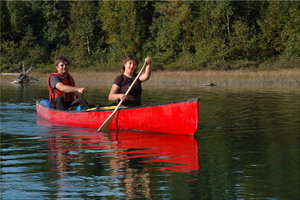
(Chris Lawson Photo)
Organized by Chris Lawson. Chronicled by Markus Wandel.
Overview map for the whole trip (also available without annotation). Detailed topo map segments are available for each day.
Here is a Google Maps Satellite view centered on the put-in location on the Montreal River. Scroll down to match the lakes visually to those on the overview map, or switch to the regular map view to determine how to get there (the turnoff from highway 560 is called Beauty Lake Road).
Chris has his own writeup about this trip.
I had heard of Ishpatina Ridge. It is the highest point in Ontario, a lonely place in the Northern Ontario wilderness with no road access near it. Then Chris mentioned that he was organizing a canoe trip to it on behalf of the YMCA Canoe Camping Club. Guests were welcome. I signed up. Since Lisa loves this sort of thing and had canoe experience already, I recruited her as well.
Preparations began as the trip drew nearer. Lisa borrowed the necessary gear from friends (thanks Tara, Caroline and Ewart), took care of the food and found a canoe rental place. I was at my parent's camp, where there is an old canoe to play with, and put in as much mileage as I could to get my arms into shape.

|
|
Markus and Lisa on the Montreal River (Chris Lawson Photo) |
Chris, Ken and Michael were waiting for us at the outfitters. After loading the canoe onto my car, we proceeded to the put-in point.
Since we were late, the loading of the canoes was rushed. I once sat down on the gunwale of my canoe, to be met with a loud creak and admonishments from my tripmates that this was a sure way to wreck it.
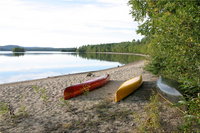
|
|
Canoes on the beach at the first campsite
|
Fortunately the river soon turned deeper, and whatever shallows came were sandy. Thus, after a few hours' uneventful and soon enjoyable paddling, we arrived on Smoothwater Lake, which counter to its reputation really was smooth that day, and found our campsite next to the portage to Marina Lake.
The campsite was beautiful, with a beach, a babbling brook, and improvised log furniture. Lisa prepared the first night's dinner, which was vegetables in rice with cold meat on the side.
Map of today's route (also available without annotation). All pictures for this day.
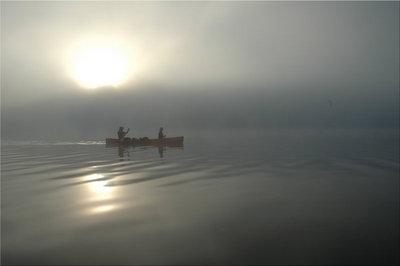
|
|
Canoeing in the fog on Smoothwater Lake (Chris Lawson Photo) |
The bottom of this lake was liquid silt. In a shallow spot, it was best to dip one's paddle into the muck and push the boat forward. Getting out was not an option as (in Ken's words) you'd "sink straight through to China".
We now donned our hiking boots for the long 1.2km portage to a chain of tiny ponds culminating (after four additional short portages) in Mihell Lake, which I thought was appropriately named given the struggle so far. As a hiker, I wondered why all this trouble, why not just put a hiking trail in? Ishpatina Ridge could easily be reached in a dayhike from Smoothwater Lake this way.
Doesn't sound like much fun, does it? We were rushing to keep up with the experienced canoeists. Another short portage and then a final 1.3km one, and we emerged on the shore of Scarecrow Lake. And just like that, we were there, on a large, beautiful body of water, the trailhead to Ishpatina Ridge less than a kilometer away on the shore. Perhaps there was something to this canoe tripping after all. And after the eternity of paddling and portaging, it was not even 1pm yet.
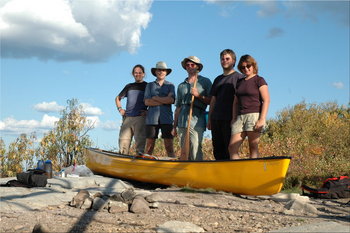
|
|
Five adventurers and one canoe, on the roof of Ontario (Chris Lawson Photo) |
Chris distrusted his GPS waypoint, and instead led us up a very clearly marked trail near our portage. But this only went to a disused ranger cabin. A search along the shore revealed the true trailhead, which agreed perfectly with his GPS.
Michael had been joking about the final portage of the day, and now he shouldered the yellow solo canoe as we began the hike, obviously meaning to carry it up the 3km trail to the top. We all wondered how far the joke would go. Having wasted time searching for the trailhead, we now marched up at full speed, but he valiantly kept up with his cargo.
It took us just over an hour to gain the top.
A sign warned us not to climb the tower, but it was in good condition and it was clear that other people had climbed it, as the lower removed ladder section was replaced by one salvaged from the remains of an earlier tower on the site, and the hatch into the cab was seen to be open. Even so, none of us climbed it, law-abiding citizens that we are. I now regret not doing so. I did, however, climb up the first 10 feet, to get an unobstructed view. The late-afternoon light and the early fall colours were glorious. From the ridge, we could see our island campsite, but it was too far away to make out the tents.

|
|
Southwest view from Ishpatina Ridge, showing Scarecrow Lake
|
Note that these two panoramas together make almost a 360 degree view. Click on them to see them much larger.

|
|
Northeast view from Ishpatina Ridge
|
After a long stay on the summit, we headed back down, taking an hour to get back to the lake. Michael actually canoed part of the way, where the trail skirted a small lake. Lisa was very tired by this point, so we set off immediately for the island, while the others loaded up their canoes with firewood. Dinner was again prepared by Lisa.
On every significant lake, we had been greeted by the resident loon with his "intruders, get out!" call (can the loon help it that this stern warning sounds so melodious to us?) But that was nothing to what awaited us in the night. Scarecrow Lake had a family of at least five birds, and their nighttime calling, echoing off the surrounding hillsides, was the most beautiful night music I have ever heard. Suddenly, I understood the romantic mystique of Northern Ontario canoe touring.
Map of today's route (also available without annotation). All pictures for this day.
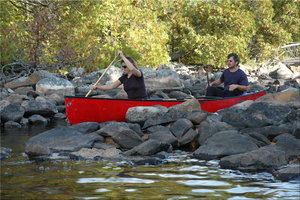
|
|
Don't you need water to canoe? (Chris Lawson Photo) |
After the usual breakfast of instant oatmeal and hot chocolate (everyone had brought instant oatmeal) we put the boats into the water to explore further south. First, we looked at a private cottage on the south shore where we had seen a float plane docked on the previous day, then we went through the passage into Woods Lake. This was full of rocks, and gave about three inches of clearance on all sides of the canoe if navigated perfectly, which the experienced canoeists did with aplomb. Lisa and I bumped our way through badly, with much trepidation on my part about rental surcharges for canoe damage.
The passage into Little Scarecrow Lake was worse, a creek section several hundred metres long where there was not enough water to float a canoe at all. In the end, the only thing that would do was to unload the canoe and float/drag it over the creek bottom.
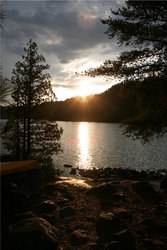
|
|
Beautiful sunset between rain episodes
|
We now found ourselves in Hamlow Lake, which has a complex shape and islands as well, and matched my previous mental stereotype of canoe touring, where you navigate through twisting, turning, connected waterways. Since it was lunchtime we looked for a nice place to land and sit, and when we found it, it was right on an overgrown logging road that turned out to be a portage into Stull Creek. It did not appear to be much used.
After lunch, with the weather turning worse but providing, for once, a tailwind, we headed back. By the time we got into Woods Lake, it started to rain. I thought with dismay of Lisas's and my hiking boots, sitting out in the open at the campsite, but that was nothing to Michael and Chris's distress, as they had left their tent uncovered! So they paddled extra fast and left us behind.
By the time Lisa and I arrived at the island, the rain had stopped, and the hiking boots, which had only gotten a little damp, rescued. I was wet and cold by this time from wind and rain, and decided it would probably not be much worse if I just went into the lake to wash off. This I did, with my biodegradable soap. I was later admonished that biodegradable soap is not for use in open water, only for dumping your soap suds well back in the woods.
The weather turned nice again, and we had a great dinner (cooked by Ken: Fettucine Alfredo with tuna, and a carrot salad) and campfire. However, after dark, a thunderstorm drew up, and I discovered to my dismay that my tent floor was no longer watertight, and the tent, set up on one of the island's few suitable flat spots, had water running underneath. Thus it got wet inside, and we had to sleep on plastic garbage bags spread out on the floor. In the night, even after the rain had stopped, it was windy and I was not able to record the loon calls with my little audio recorder, as I had hoped.
Map of today's route (also available without annotation). All pictures for this day.
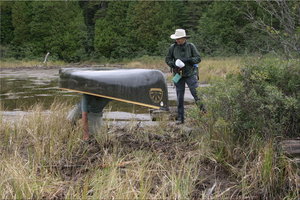
|
|
Trial by mire: Muddy portage section (Lisa Pugliese Photo) |
We stopped for lunch at a nearby rocky point. Ken showed off his camping lunch solution: Peanut butter and jelly, ready mixed in a squeeze tube, dispensed onto crispbread. Yum.
The trip along Smoothwater Lake, whose waters were no longer smooth due to the crosswind, was done cautiously, hopping along between points of land on the western shore. I had taken extra precautions to bag and secure everything in the canoe in case we got tipped over. But there were no close calls. We headed to the camping area at the northern end. There were two sites to choose from, and we took the nicer one, on gravel bar jutting right out into water. The scenery was spectacular here, but we were exposed to the wind off the lake, so we set up two of our three tents in a small sheltered area that faced north. The campfire, fed with large pieces of damp driftwood, burned furiously because of the wind.
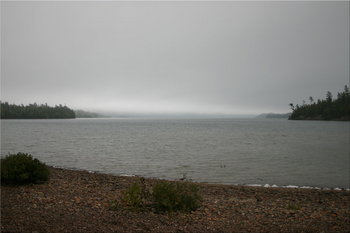
|
|
Smoothwater Lake, not smooth, from the north end
|
There were two suitable food bag hanging trees, and each had a tent directly under it. I tried to psyche Chris and Michael into moving theirs by pointing out the wash pattern in their spot which hinted that it would have standing water if it rained. But they didn't budge, and we had to hang the food bag on another tree about 300m away down the beach.
After threatening to rain all day, it now did with abandonment. The thunderstorm lasted over two hours. Huddled in the tent with Lisa, I found to my dismay that the tent roof was now leaking, a gentle rain of droplets falling onto our sleeping bags. Apparently I was the only person who did not know that an aging tent needs to be re-waterproofed occasionally.
Map of today's route (also available without annotation). All pictures for this day.
Wet and wind and sand does not for a tidy pack-up make. Everything was stuffed messily into packs - the next unpack would be in a dry basement at home. Chris and Michael's tent site had, in fact, been flooded and their sleeping bags were wet.
Chris decided that since we had about 11km to go into a direct headwind, including open water on Lady Dufferin Lake, that Lisa and I would be split up and put into the front of canoes piloted by Ken and himself, respectively. This gave me the welcome opportunity to paddle a canoe with all my strength without having to worry about steering, and we made good headway. The open lake was a chore though. Occasionally an extra fierce gust of wind, the kind that causes tiny 1cm ripples on top of the existing whitecapped waves, would blow us to a near standstill. Fortunately, most of the narrower river sections were more sheltered.
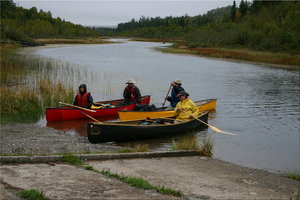
|
|
Arrived, after a strenuous headwind paddle
|
The rest of the day was spent driving back to Ottawa, with Chris at the wheel of my car because several nights of bad sleep had caught up to me. We made the obligatory ice cream stop at Laurentian View Dairy in Deep River.
And so it was done: My first big canoe adventure. In one trip, I had doubled my lifetime total canoe mileage, and increased my lifetime total portage count by a factor of 10. I think I will do more of this. And I've finally bagged Ontario's high point. Thank you Chris, Michael and Ken for letting us join you.
* * * The End * * *
Map of today's route (also available without annotation). All pictures for this day.